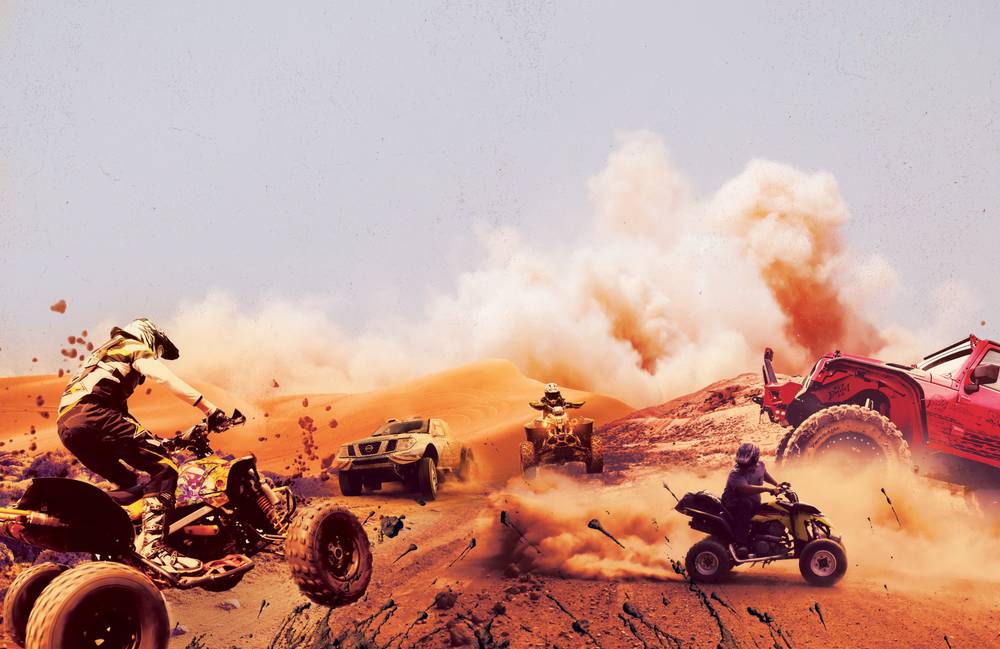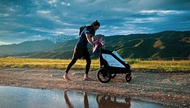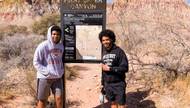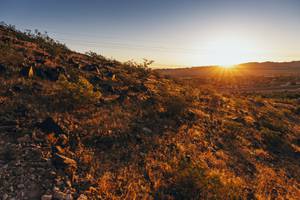Why not turbo-charge your outdoor recreation by exploring the outdoors in an OHV, or off-highway vehicle? “It’s like a roller coaster, but you’re in control of it,” says Beth Gervasi of Vegas Off-Road Tours, who goes off-roading at least twice a month. “My favorite thing about it is the wildlife. I like the scenery, and it’s super fun. It’s an adrenaline rush. You can get out there and go a lot faster than you can in just a regular car.”
Nevada’s nearly limitless trails are a gateway to your next desert adventure. But where to start? This guide will get you gassed up and going in no time.
SOLO OR GUIDED TOUR?
If you just want to dip your toe into the dirt, try a guided tour. “With a guided tour, you get all the experience of the tour guides,” Gervasi says. “We have trails that we use pretty regularly, so we maintain them, make sure there’s no huge boulders in the middle of the road or anything like that.”
The advantage of a self-guided tour is freedom. “You can stop, take more pictures. You can choose the speed that you want to go,” Gervasi says. “If you see something, you can spontaneously go check it out.”
As many outfitters do, Vegas Off-Road Tours offers both OHV rentals and guided tours. Its Polaris RZR rentals start at $399 for a two-person vehicle and $449 for a four-person vehicle, with a four-hour rental period. Guided tours start at $350 for two people for two hours (vegasoffroadtours.com).
OFF-ROADING ACRONYMS
OHV. Off-highway vehicle. Any motor vehicle designed for all-terrain use, everything from an all-terrain motorcycle to a dune buggy or snowmobile.
ATV. All-terrain vehicle. Think of a four-wheeler. ATVs have four low-pressure tires, handlebars and a seat you straddle.
SUV. Sports utility vehicle. What many of us drive to the grocery store.
UTV. Utility-terrain vehicle. Used more for work purposes than recreation.
For more information, visit travelnevada.com/off-roading/off-roading-in-the-silver-state and ohv.nv.gov.
TRAILS
With the majority of Nevada composed of public land, there are thousands of miles of trails you can explore in an OHV. Here a few highlights. (For more trail information, visit ohv.nv.gov/trails.)
Amargosa Big Dune. Zip around five square miles of sand dunes about 100 miles northwest of Las Vegas. According to the Bureau of Land Management, the 500-feet-high dunes are “an ideal recreation area for ATVs.” Unlike the dunes closer to Las Vegas, these dunes are quieter and get less traffic. blm.gov/visit/big-dune-0.
Silver State OHV Trail. Explore the nation’s first congressionally designated Off Highway Vehicle (OHV) trail series. The glory of Lincoln County is hundreds of miles long and offers access to mountains and nature of the Great Basin Desert. This trail is remote, so be sure to bring everything you might need. lincolncountynevada.com/exploring/off-roading/silver-state-trail-2.
Logandale Trails System. More than 200 miles of trails offer off-road adventure near Valley of Fire State Park. blm.gov/visit/logandale-trails.
Mormon Well Road. Located north of Las Vegas in the Desert National Wildlife Refuge, this 47-mile road offers gorgeous vistas as it takes you through Desert Pass. (NOTE: The U.S. Fish & Wildlife Service says that Mormon Well Road is not UTV/OHV/ATV accessible; all vehicles on the refuge must be street legal. If you can't drive it to the refuge, you can't drive it on the refuge. Violators of this policy are subject to fines and other penalties.) travelnevada.com/parks-recreational-areas/desert-national-wildlife-refuge.
TREAD LIGHTLY
When you head into the wilderness, it might seem like you’re free to do just about anything. But outdoor ethics apply. This land is shared not only by other outdoor enthusiasts, but also by the plants and animals who make it their home. So basically, don’t be a jerk. Leave the area better than you found it. Pick up trash. Avoid sensitive areas such as wildlife habitats. Stay on designated routes. And educate yourself so that you can safely enjoy the area without being a burden on others. For more information, visit treadlightly.org.
SAFETY FIRST
If you don’t know what you’re doing, opt for a guided tour. Outfitters will provide everything needed for a safe and fun trip.
• Be desert smart. All the rules that apply for desert safety—like bringing enough water and avoiding the heat of a summer afternoon—apply. You won’t be as physically exhausted zooming around on a motorized vehicle as hiking, but a fun afternoon can turn deadly if you get a flat you can’t fix and don’t have enough water handy.
• Don’t rely on a cell signal. Many of these glorious natural trails aren’t in cell range. Plan ahead by bringing paper maps and a personal locator beacon or satellite messenger, which can save your life if you’re stranded in the wilderness. Some outfitters provide safety beacons with their vehicle rentals.
• Wear protective equipment. The right protection depends on what vehicle you choose. But whatever it is, wear it. Don’t be one of those people who opts not to wear a helmet because it cramps their style.
• Bring a spare … or two. Depending on your terrain, you might need more than one spare tire. You might also need to bring tow rope, a spark arrestor, tools, nuts and bolts, gas, oil, a flashlight and a first-aid kit.
Click HERE to subscribe for free to the Weekly Fix, the digital edition of Las Vegas Weekly! Stay up to date with the latest on Las Vegas concerts, shows, restaurants, bars and more, sent directly to your inbox!





